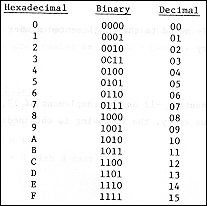M1975-1980-6502-WP.DOC
6502 Microprocessor and Word Processor

Diagram of registers in the 6502 Microprocessor

Mnemonic Codes for Machine Language Programming the Processor
In order to maximize the use of early machines it was necessary to learn how to program in “machine code”, the language of the microprocessor. This was before such things as DOS let alone word processors. My initial interest and knowledge of microprocessors was using a 6800 Motorola Microprocessor in an early machine when experimenting with digital electronics methods for a pending MX missile. Thus when I obtained my first Commodore PC I had more in mind than it’s conventional use. I thought of how to use it as a test instrument. Having first known a bit about the 6800 I was impressed with extra features in the 6502.



Variations in Microprocessor Addressing Modes
RCA and Motorola were among the first to make use of CMOS which made microprocessors possible. My first appreciation of a microprocessors architecture was from studying such a design by RCA – RCA dropped microprocessors early on but continued with CMOS devices.

More Microprocessor program variations
With the added Autonetics Microelectronics production, the 6502 became the most widely used microprocessor and I was able to take after work classes from Art Hamond the chief engineer and able to follow the state of the art as it was happening. To harness the new microprocessors it was necessary to have an associated family of 8 bit registers to interface with the outside world – and to include RAM (Random Access Memory) chips for running programs.

Internal Architecture of a 6502 Microprocessor

By converting binary to hexadecimal a four
column memory display could be shown as a single column
This entered a new domain of decimal, binary, hexadecimal numbers and the world of 1’s and 2’s complement numbers – which are an essential part of performing arithmetic.
In the beginning Intel concentrated on making memory chips and had not started their x86 processor series.

Organization of Microprocessor System, with Address, Data & Control Buss’s
Computer motherboards were among the first to use printed circuits of a refined quality. These permitted running multiple parallel “bus” wires.
BIOS (built in operating system) in the ROM controlled such things as interrupt protocol, and the microprocessor implemented software commands. Initially there were three buses on the motherboard: control signals, addresses, and data. The data bus was 8 bits, the address bus 16 bits and the control bus about 12 bits (printed wires) wide. Multiple card methods were in use but one but one mother board was more economical.
Word Processor Program
At age 40 I went back to school taking night classes. As an escape from engineering I took a variety of subjects as Astronomy, Biology, Geology, World History, World Religions, etc. Each required writing a paper. I decided it would be much easier if I write and save with the computer rather than pay a secretary to type my poor writing into something readable. This began an effort to write a word processor program. Some had written such in Basic but these were very slow. It took time and tenacity but was able to write a word processor by tapping into the software stored in the Commodore ROMs. Once I got the hang of it I was able to produce an quite functional word processor.
Some two years later a program called ”X Y Write” could be purchased which was also written to use Microsoft Software then available on a floppy disk – and later applicable to IBM compatible machines.
Space Cell My initial endeavor was to full fill an Astronomy class assignment, a book report on an astronomy based Science Fiction story. I believed I could write something better than what I found, I wrote my own called “Space Cell”. It was based on the idea it would be necessary to escape earth as it will eventually be destroyed when the sun expands to include Earths orbit. The idea was to make a Noah’s Arch Cell filled with DNA of Earths primary life forms. The Cell to be like a “seed” launched from Earth to a find a new shore. I didn’t have time to complete the story as I kept running into problems to solve, so turned in a paper on what the story idea. When bidding good by to the instructor he said that was a fantastic story concept adding what ever you do complete the story. Thus I was motivated to have functional word processor.


Internal architecture of 6520 Peripheral Interface Adapter chip Signal Timing
B-1B program When North American Aviation division of Rockwell was told to restart the B-1B program I was among a few sent to help. John Cox and I took two Commodore computers with us and used the word processor program I’d written. Ours were the only such machines in their division.
I modified my word processor to also do arithmetic within text and we later used it to make a large matrix of requirements for some 200 boxes of of B-1B electronics attributes. I later wrote a program in Basic for evaluating ATE (Automatic Test Equipment) in the US inventory for applicability to the B-1B needs.
I made copies of this software for other Autonetics personnel with Commodore computers.
I later wrote a program in machine code, to evaluate proposals for B-1B Automatic Test Equipment.
When Microsoft Word for IBM compatible machines came out it was very slow, so I wrote them a letter stating they needed to write it in machine code to speed it up as I had for the Commodore machines. About 4 months later I received a very nice letter from them suggesting I try out their new version of Word, rewritten in machine code as I’d suggested.